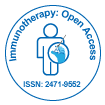
Immunotherapy: Open Access
Open Access
ISSN: 2471-9552

ISSN: 2471-9552
Opinion Article - (2024)Volume 10, Issue 3
Allergies affect millions of people worldwide, leading to a range of uncomfortable and sometimes dangerous symptoms. Traditional treatments have focused on avoidance and medications, but Sublingual Immunotherapy (SLIT) offers an alternative that aims to change the way allergies are managed.
SLIT involves administering allergen extracts under the tongue to help desensitize the immune system. This approach aims to slowly decrease allergic reactions by exposing the body to minimal amounts of the allergen, encouraging the immune system to develop tolerance over time.
Mechanism of action
Allergen exposure: During SLIT, a small dose of allergen (e.g., pollen, dust mites or specific food proteins) is placed under the tongue. The allergen is absorbed directly into the bloodstream through the mucous membranes.
Immune response: This exposure trains the immune system to recognize the allergen without overreacting. Over time, the body becomes less sensitive to the allergen, reducing the severity of allergic reactions.
Dosing protocol: Patients typically start with a very low dose of the allergen, which is gradually increased during follow-up visits. This up-dosing phase can last several weeks.
Once a maintenance dose is reached, patients continue to take this dose daily for an extended period, usually three to five years.
Benefits of SLIT
Convenience: SLIT is generally easy to administer at home, requiring no injections, making it a more accessible option for many patients.
Fewer side effects: Compared to traditional allergy shots SLIT tends to have fewer and milder side effects, such as localized mouth irritation or mild gastrointestinal symptoms.
Improved quality of life: Many patients report significant improvements in allergy symptoms, leading to a better overall quality of life.
Safety and considerations
While SLIT is considered safe for many patients, it is essential to discuss potential risks with a healthcare provider. Some individuals may experience:
• Local reactions (itching or swelling under the tongue)
• Gastrointestinal symptoms (nausea or discomfort)
• Rarely, systemic allergic reactions
• Patients are typically monitored during the initial phases of treatment to ensure safety.
Comparison with other allergy treatments
Medications commonly prescribed for allergies include antihistamines, decongestants, corticosteroids and leukotriene modifiers. These medications work by alleviating symptoms through mechanisms such as blocking histamine release, reducing inflammation or constricting blood vessels. However, while they can effectively relieve symptoms, they do not address the underlying allergy and often require regular use.
Subcutaneous immunotherapy or allergy shots, involves injecting a controlled dose of allergens into the body on a weekly or bi-weekly basis. This treatment aims to gradually desensitize the immune system, helping to reduce sensitivity over time. However, allergy shots necessitate regular visits to a healthcare provider, which can be time-consuming and inconvenient. Additionally, they may carry a risk of more severe side effects.
Long-term outcomes
Ongoing study suggests that many patients may maintain long-term benefits even after completing SLIT. Some studies indicate that tolerance to allergens can persist for years, reducing the likelihood of symptom recurrence after treatment ends. This is a significant advantage over traditional symptom management strategies.
Future directions
Ongoing study is focused on optimizing SLIT protocols, understanding the long-term effects of treatment and expanding the range of allergens that can be effectively treated. Scientists are also exploring combination therapies that could enhance the efficacy of SLIT, such as pairing it with other forms of immunotherapy or new biologic agents.
SLIT represents a significant advancement in allergy management, providing a viable option for many individuals seeking relief from their symptoms. As our understanding of allergies and immune responses evolves, SLIT stands out as a potential and patient-friendly approach to achieving lasting tolerance and improving quality of life.
For those considering SLIT, consulting with an allergist or healthcare professional is essential to determine the best treatment plan customized to individual needs and allergy profiles. With ongoing advancements in this field, there is a great potential for individuals living with allergies.
Citation: Ishiwara H (2024). A Comparative Analysis of Sublingual Immunotherapy and Conventional Treatments. Immunotherapy (Los Angel). 10:261.
Received: 21-Aug-2024, Manuscript No. IMT-24-34644; Editor assigned: 23-Aug-2024, Pre QC No. IMT-24-34644 (PQ); Reviewed: 09-Sep-2024, QC No. IMT-24-34644; Revised: 16-Sep-2024, Manuscript No. IMT-24-34644 (R); Published: 23-Sep-2024 , DOI: 10.35248/2471-9552.24.10.261
Copyright: © 2024 Ishiwara H. This is an open-access article distributed under the terms of the Creative Commons Attribution License, which permits unrestricted use, distribution and reproduction in any medium, provided the original author and source are credited.